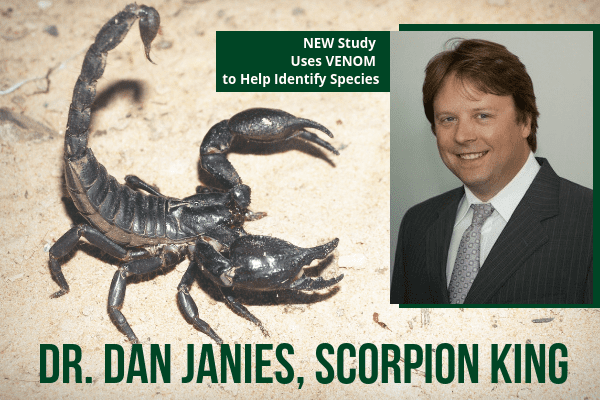Scorpion King

Dr. Dan Janies, Distinguished Professor of Bioinformatics and Genomics at UNC Charlotte’s College of Computing and Informatics, is a risk taker. Much of Janies’ recent work has been in the study of infectious diseases. Not satisfied studying data from behind the safety of a keyboard and monitor, Janies has traveled the world, mapping the progression and causes of large-scale outbreaks of Salmonella, malaria and meningitis.
As if seeking a new thrill, Janies and members his lab (John Williams, Zach Witter, and Nathaniel Rush) dipped into the science of scorpion venom, contributing to recently-published studies of the evolution of new bioinformatics tools, and databases to study all kinds of venom.
There are more than 2,400 species in the order Scorpiones. Scorpion venom can be deadly to humans but most scorpions have evolved to possess venom specific to the task of taking down its target prey. Historically, studies have focused only on those that are a threat to people. However, understanding the differences in the many species and how the venom differs requires untangling a messy tree of life, which has evolved over the past 300 million years.
Janies’ group joined Carlos Santibáñez-López, a postdoctoral researcher, and Prashant Sharma, an Assistant Professor of Integrative Biology (both at the University of Wisconsin – Madison), to look at the molecular structure of scorpion venom proteins as a way to distinguish between major branches of the scorpion tree of life. Instead of using the arachnids’ bodies which have proven unreliable in tree of life studies, the team found that the molecular shape of venom protein can be used to distinguish two large branches of the scorpion tree of life.
The venom protein structure data was combined with more-than 3,000 other sequences of active genes from 58 exemplar scorpions and 12 near relatives, to untangle the scorpions’ complex evolution. Understanding how a venom’s shape has evolved and become customized to better disrupt nerve cells in its prey will help us predict how big a threat a certain species is to human. If this research, and the associated databases and bioinformatics tools are expanded to other venomous creatures, there is a reasonable an expectation for similar findings.
To read the Complete Papers, go to: https://peerj.com/articles/5902/
The databases can be accessed at: http://venom.space
Additional tools for the study of venom created by UNC Charlotte’s Department of Biology and Departments of Bioinformatics and Genomics are at: https://peerj.com/articles/5361/